They are also fantastic when blossoming (and full of fruit), so a valuable edimental in any case!
And, yes I do save the seeds for sharing with Norwegian Seed Savers (kvann.no).
At the Væres Venner community garden on the outskirts of Trondheim at Ranheim in an area we hope will remain a green belt, I have been working to create what we call Verdenshagen (The World Garden) in collaboration with KVANN (Norwegian Seed Savers) and Schübelers nettverk. This is a network of gardens throughout Norway which is being launched in June 2021 in honour of Fredrik Christian Schübeler (1815-1892) was a botanist and professor at the University in Christiania (now Oslo) and director of the Botanical Gardens for nearly 30 years from 1863. He established a network of gardens throughout Norway, often in collaboration with prestegård (rectory gardens) to test out new plants of economical importance (both ornamentals and edibles). Our new network is also planned centred around rectory gardens and other gardens to demonstrate and inspire to grow new plants but also to conserve old varieties of food plants and ornamentals. See more at https://translate.google.com/translate?hl=en&sl=no&u=https://kvann.no/schubeler
The World Garden is basically a 12 m diameter circle where the centre represents the North Pole and houses a garden of Arctic food plants. Largely perennial vegetables are being planted geographically around the circle, currently some 80 plants, many of which can be read about inspired by my own book Around the World in 80 plants (see http://www.edimentals.com/blog/?page_id=30). The garden is surrounded by over 100 old and new fruit, berry and nut trees and another demonstration garden for annual crops.
The intention is to add pictures to the album below throughout the year from the World Garden. Our focus is also in creating and improving the habitat at Være for other wildlife, so there will also be pictures of insects, birds and other creatures.
Norwegian: for en norsk oversettelse av denne artikkelen (Norwegian translation), se KVANNs (Norwegian Seed Savers) Nyhetsbrev #15
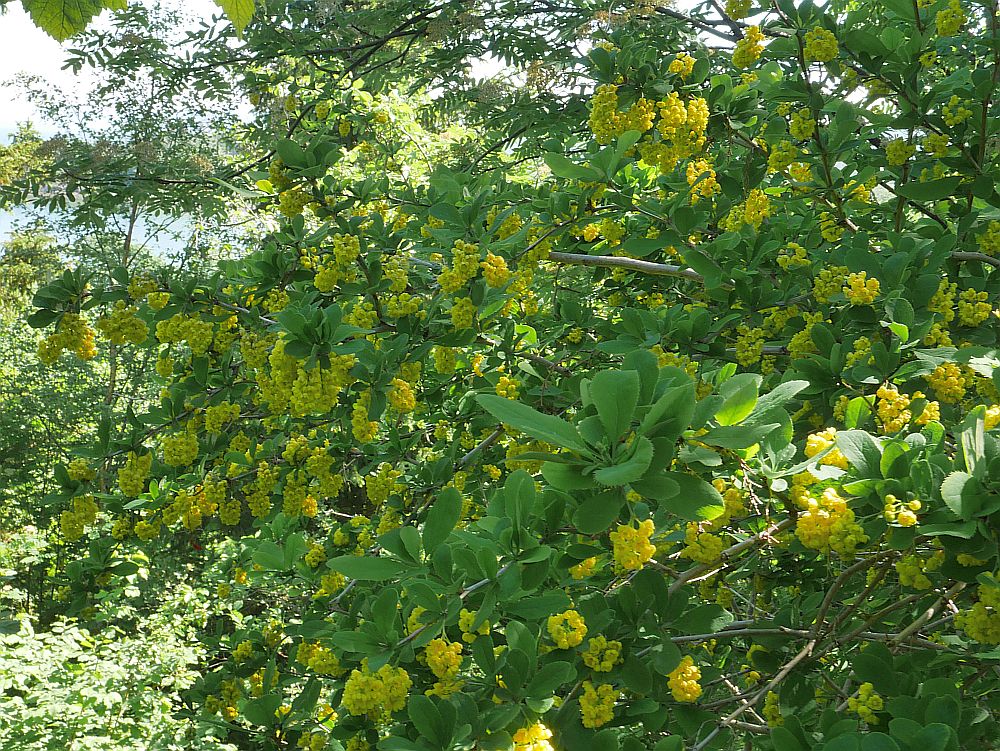
There’s always been a barberry (Berberis vulgaris) in my garden, in dry soil in the root zone of my largest spruce trees. It was a large plant when we moved here in 1984 and may be wild as it’s a common plant on the other side of the bay (Malvikbukta) where it grows on shallow dry soils next to the fjord in company with sea buckthorn (Hippophae tamnoides). It is thought that this species was originally introduced in monastery gardens and later naturalised. It’s nowadays a relatively common but local plant along the Trondheimsfjord, but isn’t found much further north.
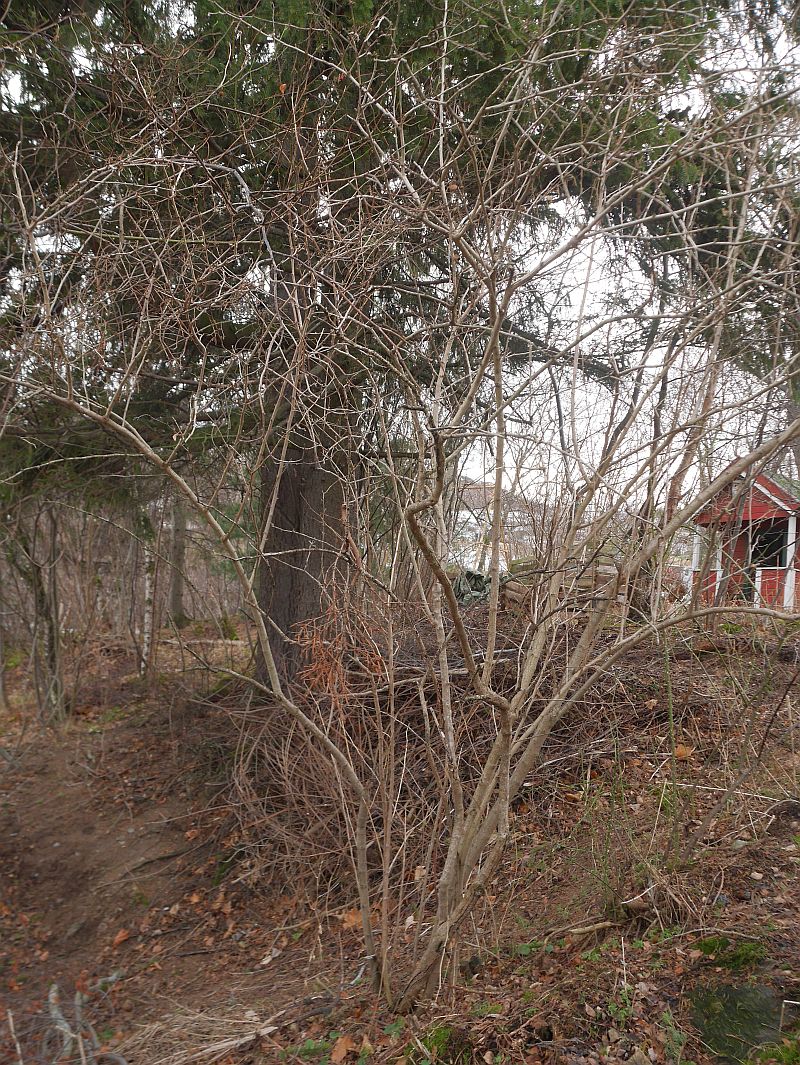
I also planted one next to the kitchen window in order to get good views of waxwings (sidensvans) and thrushes (troster) that feast on the berries in autumn and winter: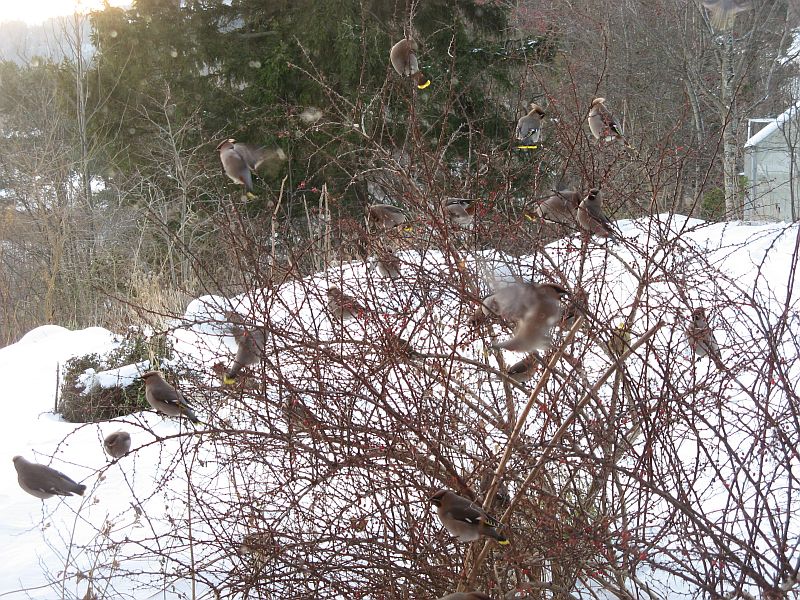

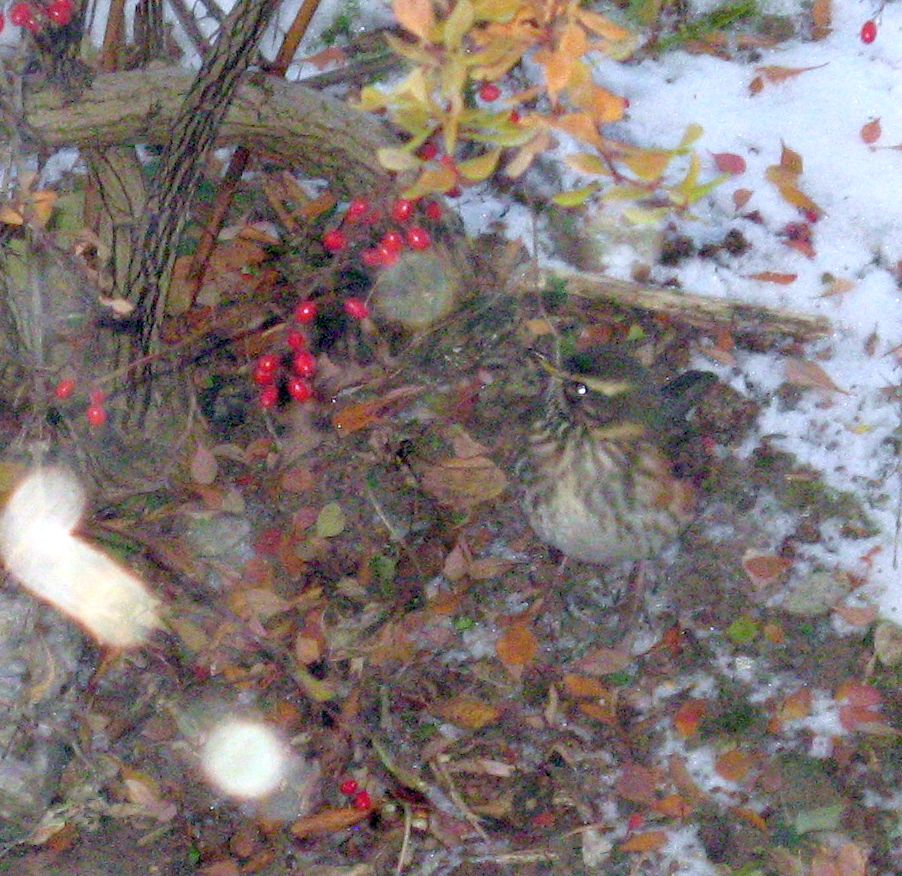
I also have a form with dark berries which I propagated by seed which I received in 1998:
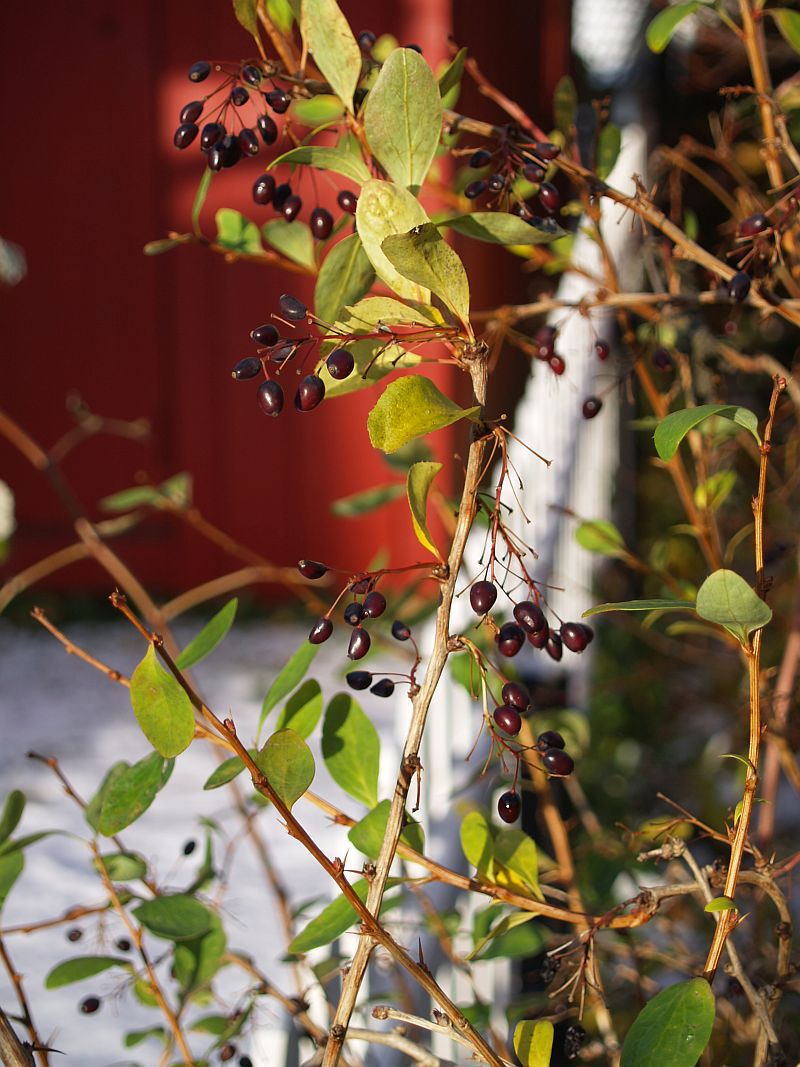
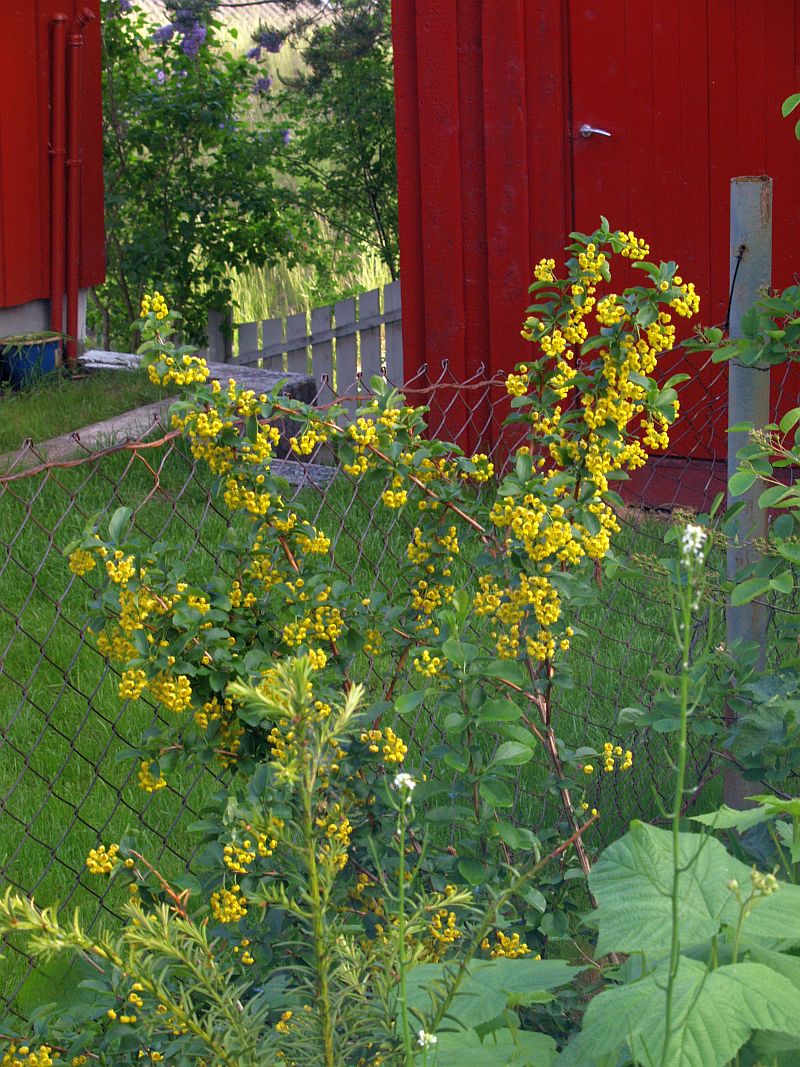
Ethnobotany
There are many species of Berberis, and the closely related Mahonia, which many botanists consider to be a part of Berberis, that have been used traditionally for food around the world. In South America, several species were used including the fruit of the michay (Berberis microphylla) used by the Mapuche people of Chile and Argentina. Numerous Native American tribes used various Mahonia species both fresh and dried, for jelly and jam, tea, wine and lemonade. In Japan, several species are used for drinks and at least one species is used for a drink in China. 7 species are known to be used in Nepal, both eaten fresh, pickled, distilled into alcohol and in the case of Berberis chitria, the seeds are roasted. Fruit of Mahonia acanthifolia and Mahonia napaulensis are also eaten fresh and pickled. Another Himalayan barberry (Berberis asiatica) is said to make the best Indian raisins.
However, it is in Iran (and neighbouring Afghanistan) that barberries are really an important part of the national cuisine(s), notably zereshk polow (literally barberry rice). The eastern Iranian province of South Khorasan is the main production area of seedless Iranian barberries on (in 2014) 11,000 ha and over 9,000 tonnes of dried fruit. Cultivation goes back 200 years or so. Most authors consider that the seedless barberry, which is propagated by suckers, is Berberis vulgaris var. asperma but others that it is a form, or hybrid, Berberis integerrima ‘Bidaneh’ (bidaneh meaning seedless). Difficulty of propagation, the spiny nature of plants and the tendency to yield every other year are problems being addressed.
I like to let the birds, and in particular waxwings, take most of the barberries. However, I normally dry a few for my dried fruit mixes which I have for breakfast once the fresh apples are finished normally from April to when the first fresh fruit is available again in July (see https://www.edimentals.com/blog/?p=25352). However, this year there were very few waxwings and I dried many more than normal (over the wood stove).

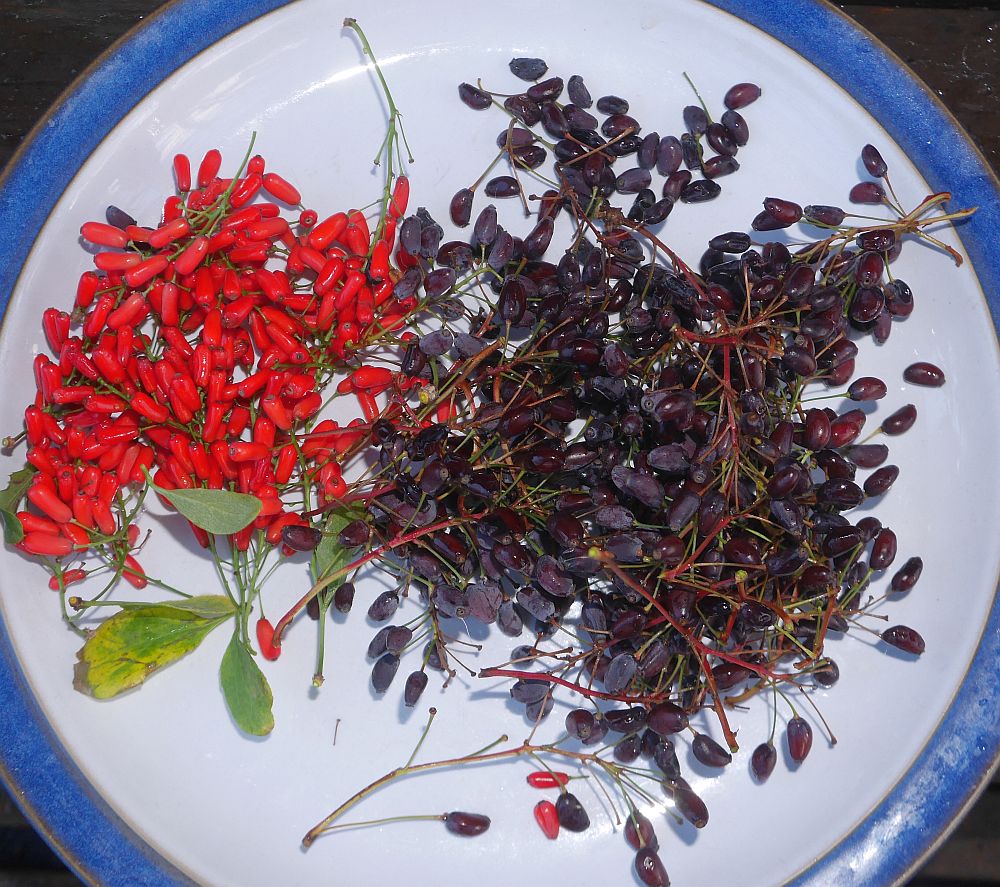
 Dried barberries
Dried barberries
I’ve been inspired by Persian cuisine many times over the years, like the Persian spice golpar from the seeds of Heracleum persicum and other Heracleum species, now the spice I use more than any other (see https://www.edimentals.com/blog/?s=golpar) and Persian shallots (see https://www.edimentals.com/blog/?s=persian+shallots).
I therefore decided to try using my dried Berberis harvest in various Iranian dishes. The first was just to give a “lemony zing” to rice. I ground the dried berries and just sprinkled on the rice before serving. 


There are numerous recipes for preparing zereshk polow which you can find easily by searching on the net (including youtube videos). It’s either a layered rice dish, but the rehydrated berries are usually sprinkled on the top as a jewel-like decoration. The berries are either rehydrated by soaking in cold water for 5-10 minutes or quickly in hot water. They are also added to melted butter which plumps them up. Saffron is often an ingredient (South Khorasan is also an important production area for saffron). The Iranian spice mix, which often contains golpar (ground seeds or the flower petals of Heracleum persicum). The pilow is usually steamed and often onions, garlic and almond slices are included. I’d like to adapting this using barley or rye grains in place of the rice.
Other Ethnobotanical Uses
I’ve also recorded other uses of Berberis vulgaris in the ethnobotanical literature in Europe and West Asia:
Czech Republic: Snack food for children
Estonia: Spice for fermented cucumbers
Slovakia: Young shoots eaten raw in spring or added to sauces
Bulgaria: Fruit added to soups as a sour taste
Turkey: Used fresh or dried
Basque Country (Spain): Young shoots are eaten
Other species
In 2011 on a visit to the Dublin botanical garden, I tasted my way through a nice collection of Berberis in fruit and two of them stood out with good taste:
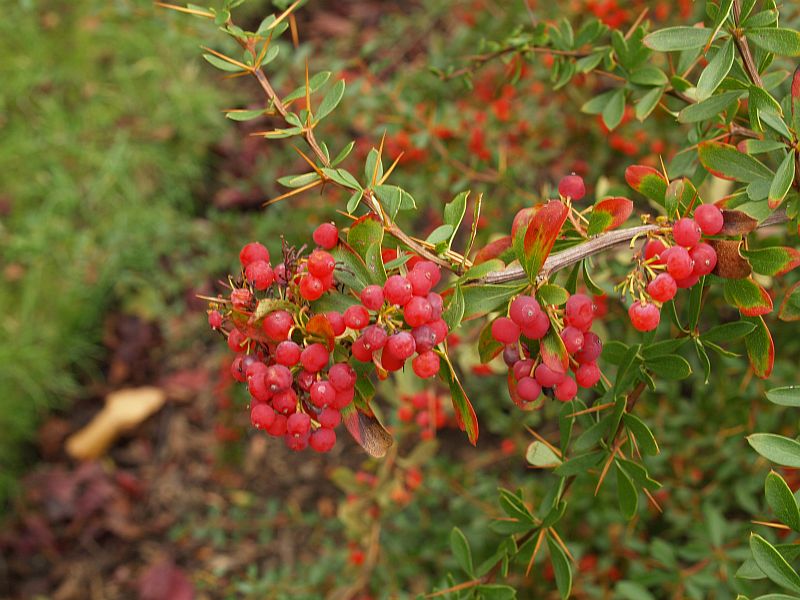
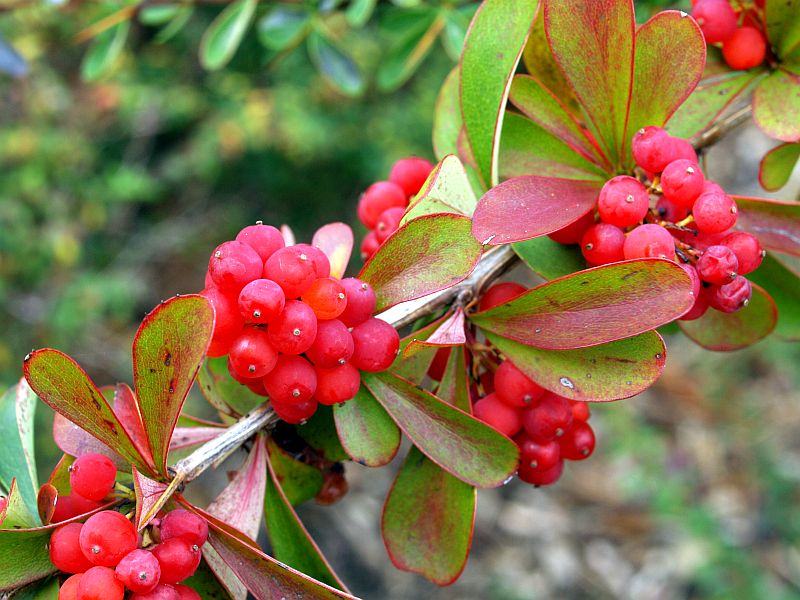
Nutritionally, Berberis fruits are rich in vitamin C (similar to citrus).
In some areas, it may be unadvisable to plant Berberis vulgaris as it is an alternative host for the stem rust Puccinia graminis of wheat and barley. However, modern day varieties are usually resistent.
Here’s 24 of the 26 potato varieties I grew this year. Many are from the national potato preservation project administered by the Norwegian Seed Savers (KVANN). 10 different varieties(mini-tubers) which have been cleaned for virus are offered every year. Some of the smaller ones are small as they were started from mini-tubers (used as seed potatoes next year).
The varieties are from left to right:
TOP ROW: Tysk Blå; Eggeplomme; Gjernes potet; Sverre; Rosenpotet; Lange’s potet; Ingeleivs; King Edward Troll
SECOND ROW: Ivar; Blå Kerrs Pink; Gamle Raude; Svart Valdres; Buddhisten fra Snåsa; Ringerikspotet; Svartpotet fra Vegårshei (syn. Blå Kongo); Abundance
BOTTOM ROW: Beate; Rocket; Shetland Black; Sharpe’s Express; Brage; Hroar’s Drege and Sarpo Tominia
 I’m not head-banging to the potatoes….honest:
I’m not head-banging to the potatoes….honest: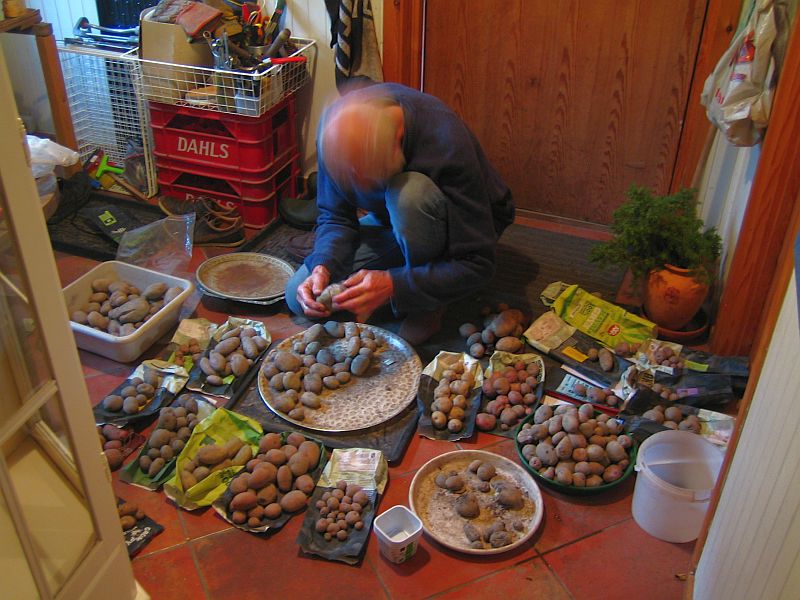


This is what ALL window sills in the home of a seed saver look like in October :)
Join KVANN (Norwegian Seed Savers) if you’d like to share this harvest…https://kvann.no/bli-med
I’ve been growing the blight resistent potato Sarpo Tominia every year since 2004 and it’s still going strong, showing no sign of lack of vigour, continuing in full growth right up to the first heavy frosts with fantastic yields. In the UK, this variety was deemed too similar to Sarpo Mira to be continued. However, my observations are that Tominia yields a bit better than Mira here, probably because it is a bit earlier. This makes little difference in the UK, but could be significant here in Norway where growth is stopped by early frosts.
Norwegian Seed Savers (KVANN) administer a national program offering 10 virus cleaned varieties from our national list of some 80 traditonal varieties each year. Members are not allowed to pass these varieties on to others, but can save their own seed potatoes. This is to reduce the spreading of virus and other diseases. We will reoffer most varieties of interest after some years. For the same reason we have also included other popular non-commercial varities in the program and Sarpo Mira has been included for some years now. Members are sent 3 mini-tubers of each variety and these are then used to produce seed potatoes for the following year.
We will now be including Sarpo Tominia in the programme and hope to be able to carry out comparative trials between these two varieties in a couple of years. Here is my harvest yesterday. These were grown in a very shady part of the garden with maximum 1 hour direct sunlight in summer and none when the tubers are forming!


I’ve grown numerous forms of garden orach (Atriplex hortensis; hagemelde) over the years as they are useful and decorative (edimental) annuals for the summer garden. Even though they are grown quite close to each other they don’t see to cross much. My red form (var. rubra) has maintained its colour for over 20 years in one small patch. Other favourites include golden orach (var. aurea) and an heirloom from Seed Savers Exchange in the US “Marie Barnes”. My favourite though is the Norwegian heirloom “Backlund/Bly” with enormous green leaves. Sadly, the seed doesn’t mature often here and I’ve lost it. Although this plant originated in Norway, it no doubt modified to its new home in the Mid-West in the US where it was maintained for several generations in a Norwegian family. See the (Norwegian) story here:
http://www.edimentals.com/blog/wp-content/uploads/2018/07/3_Backlund-Bly_Hagemelde.pdf
There are also a number of green Danish heirlooms like “Lille Næstved Skole”
You can maybe spot red and golden orach as well as “Marie Barnes” in this salad ingredient picture (click on the plants in the picture for the names) https://www.adressa.no/pluss/magasin/article9858403.ece?rs6280711594805805236&t=1
I use them mainly in summer, both in mixed salads and cooked in numerous dishes, as there are plenty of other perennial greens available in early summer.
See the pictures below:
19th June 2020: Video update from the Allium (Chicago) garden at the NTNU Ringve Botanical Gardens in Trondheim. The heat wave has brought many species into flower and the garden’s looking great!
The official opening of the garden, planned for August, has been postponed to 2021. We are working on plant signs which will hopefully be added later in the summer.
The garden currently contains some 300 accessions including around 100 Allium species and many old Norwegian onions collected over several years from all over the country and funded by Norsk Genressurssenteret and Landbruksdirektoratet.
The signs for the garden are in part funded through a gift from Skjærgaarden (https://www.skjaergaarden.no) to KVANN (Norwegian Seed Savers) who have decided to use the gift at Ringve (see https://www.facebook.com/skjaergaarden.no/videos/2972781459487864)

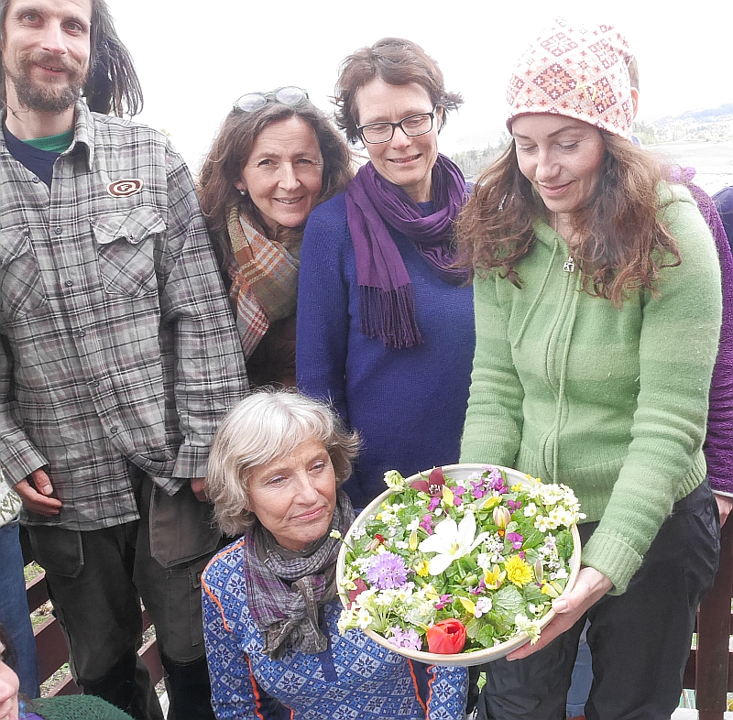
Norsk: Se lengre ned på siden
English: This is the course for you who want to learn more about perennial vegetables and forest gardening in a course held in and around Norway’s world-renowned Edible Garden, now one (of 4) Permaculture Land Centres in Norway, led by author and head of KVANN / Norwegian Seed Savers, Stephen Barstow. There will be lectures on Allium, an extended garden walk, making lunch and dinner with spring harvested produce, foraging on the shoreline and the ostrich fern tour along the Homla river canyon. Full program, pictures and link to pictures in the pdf at the bottom
It is also possible to extend your stay to Monday when we will work together in KVANN’s gardens at Væres Venner in Ranheim on Monday 11th May.
Course fee and registration: You must either be a member of KVANN or the Norwegian Permaculture Association. NOK 1600 (for the whole weekend) for KVANN members (membership costs NOK 250), NOK 1800 for members of the Norwegian Permaculture Association. Kr. 900 for students and unemployed. There is a binding registration when paying the course fee. VIPPS to 91529516 (private). Bank account: 82306086762. This course has been fully subscribed all the times it has been arranged in the past with a waiting list. If you sign up but are later prevented attending, there are good chances of finding someone take over your place and we will help advertising that!
Sign up to sbarstow2@gmail.com with your name, address, email, phone and year of birth (we need this information because we are seeking support from Studieforbund Natur og Miljø)
Norsk: Dette er kurset for deg som vil lære mer om flerårige grønnsaker og skogshaging i og rundt Norges verdenskjent Spiselig Hage, nå et (av 4) Permakultur Land Sentre i Norge, ledet av forfatter og leder av KVANN, Stephen Barstow. Det blir foredrag om Allium, utvidet hagevandring og felles matlaging, sanketur i fjæra og strutsevingetur langs Homla. Fullt program, bilder og lenk til bilder fra de 3 tidligere kurs kan man laste ned nederst på denne siden.
Det er også mulighet å være med på dugnad i KVANNs hager hos Væres Venner mandag 11. mai.
Kursavgift og påmelding: Man må enten være medlem av KVANN eller Norsk Permakultur Forening. Kr. 1600 (for hele helgen) for medlemmer av KVANN (medlemskap koster kr. 250), kr. 1800 for medlemmer av Norsk Permakultur Forening. Kr. 900 for studerende og arbeidsledige. Det er bindende påmelding ved betaling av kursavgifta. VIPPS til 91529516 (privat). Bankkonto: 82306086762. Dette kurset har blitt fulltegnet alle ganger tidligere med venteliste. Om man tegner seg på, men senere blir forhindret er det gode sjanser for å få noen til å ta over plassen din og det skal vi hjelpe til med!
Påmelding til sbarstow2@gmail.com med ditt navn, adresse, epost, telefon og fødselsår (dette trenger vi fordi vi søker støtte fra Studieforbund Natur og Miljø).
Updated 24th Feruary 2020
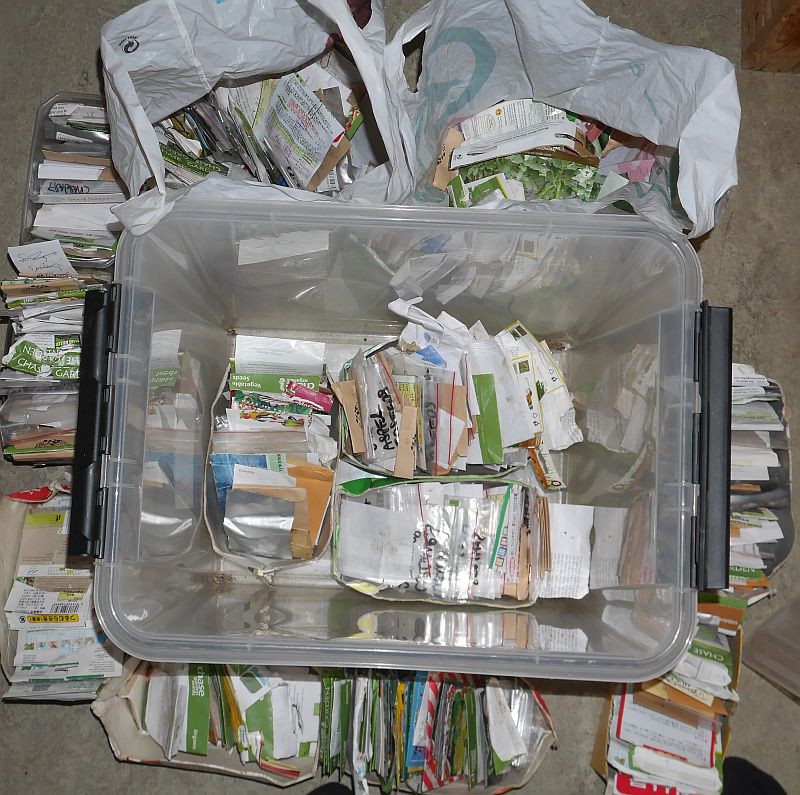
WELCOME TO MY NEW SEED TRADE LIST FOR 2019-20, THIS YEAR WITH 390 VARIETIES
17, 18, 19 in brackets indicates the harvesting year for the seed. Concerning seed quantity: as I don’t have many plants of each species, seed quantity is limited in most cases. Therefore, for some species you may only get a few seeds. Many species are harvested in my garden. Others are surplus from trade and purchase. OUT: Means out of stock. NB! Cultivars do not always come true. I offer them anyway, but no guarantees to what you will get! NB! Traditional vegetables are at the end of the list with (mostly) common English names first.
NOTE: I don’t sell seed and I won’t be doing many trades this winter due to a busy schedule. However, I offer all plus many more to members of Norwegian Seed Savers (KVANN) through our spring (February) year book and autumn catalogue. To become a member go to http.//kvann.no and click on “Bli med”. It costs kr. 250 / year plus postage and packing.
For trades, I am mainly interested in uncommon hardy perennials, but I may also be interested in annuals.
NB! Not all plants in this list are edible, although almost all are!
Botanical Name (year of harvest)
Aconitum lycoctonum (17) Poisonous
Adenophora bulleyana (18)
Adenophora khasiana (17)
Adenophora lilliifolia (17)
Adenophora pereskiifolia alba(17)
Adenophora remotiflora (17)
Adenophora tashiroi (17)
Adenophora triphylla v japonica (17)
Adenostyles alpina (17)
Agastache foeniculum (19)
Agastache rugosa (18)
Akebia quinata (19)
Alcea rosea (18)
Allium acuminatum (18)
Allium aflatunense (18)
Allium albidum (18)
Allium amethystinum “Forelock” (18)
Allium anisotepalum (19)
Allium atroviolaceum (18)
Allium barsczewskii (18)
Allium bekeczalicum (19)
Allium bekeczalicum x alaicum (19)
Allium brevicaule (19)
Allium caesium Ex-Kyrgyzstan (19)
Allium canadense bulbils (19)
Allium carinatum pulchellum (18)
Allium carinatum pulchellum “Album” (19,18)
Allium carolinianum (19) (2 accessions)
Allium cernuum mix (19)
Allium cernuum ‘Tall Mix’ (17)
Allium cretaceum (19)
Allium darwasicum (19)
Allium decipiens (18)
Allium erubescens (18)
Allium cf. erubescens (19)
Allium fetisowii (18)
Allium fistulosum Ex-“Auen 4” (18)
Allium fistulosum Ex-“Bygland” (18)
Allium fistulosum Ex-“Gribovskij 21” (18)
Allium fistulosum Ex-“Leppasyrja” (18)
Allium fistulosum Ex-“Neset” (18)
Allium fistulosum Ex-“Svenskelauk” (17) (Norwegian heirloom onion)
Allium flavescens (18) (Open pollinated hybrid)
Allium flavum (18,17) several varieties
Allium fuscoviolaceum (19)
Allium globosum (19)
Allium gultschense (19)
Allium gunibicum (19)
Allium hymenorrhizum (19)
Allium insubricum (19)
Allium jajlae (19)
Allium jesdianum “Akbulak” (19)
Allium karataviense (19) 2 accessions
Allium karelinii (19)
Allium korolkowii (19)
Allium lenkoranicum (19)
Allium lipskyanum (19)
Allium macranthum (19)
Allium macrostemon var uralense (18)
Allium mairei (18)
Allium maximowiczii (18)
Allium nigrum (19)
Allium nutans “Ex-Berkutenko” (18)
Allium nutans Ex-“Caroline” (19)
Allium nutans “Isabelle” (19)
Allium nutans Ex-“Lena” (17)
Allium nutans Ex-“Russia/A305” (19)
Allium nutans / flavescens hybrid? (Kazakhstan) (white flowers) (19)
Allium obliquum (19)
Allium oschaninii (19)
Allium ovalifolium (17)
Allium ovalifolium var. leuconeurum (19)
Allium paczoskianum (19)
Allium paniculatum (19)
Allium paradoxum normale (17) Two accessions
Allium platyspathum (19)
Allium praescissum (19)
Allium pskemense x cepa (19)
Allium ramosum (19)
Allium rotundum (19)
Allium rosenbachianum (19)
Allium sarawschanicum (19)
Allium saxatile (19)
Allium schoenoprasoides Ex-Kazakhstan (19)
Allium schoenoprasum “Bergsbygrenda” (17) Norwegian heirloom
Allium schoenoprasum “Black Pedicels” (17)
Allium schoenoprasum “Bohemia” (17)
Allium schoenoprasum “Erecta” (17)
Allium schoenoprasum “Prazska” (17)
Allium schubertii (17)
Allium severtzovioides (19)
Allium sewerzowii (19)
Allium spirale (19)
Allium splendens (19)
Allium stenodon (18)
Allium stipitatum “Goliath” (19)
Allium stipitatum “Mount Everest” (19)
Allium strictum (18)
Allium suaveolens (19)
Allium thunbergii “Ozawa” (19)
Allium tianschanicum (19)
Allium trachyscordum (18)
Allium triquetrum (18)
Allium tuberosum(19)
Allium unifolium (18)
Allium ursinum (18)
Allium victorialis ‘Granvin, SW Norway’ (18) Wild collected
Allium victorialis ‘Ex-Hopen, Norway’ (17)
Allium victorialis ‘Ex-Lofoten’ (18)
Allium victorialis “Ex-Massif Central” (19)
Allium victorialis ‘Ex-Ringve’ (19)
Allium victorialis “Ex-Tei, Japan” (19)
Allium wallichii (19) Several OP accessions
Althaea officinalis (17) 2 accessions
Amaranthus chlorostachys (18, 17)
Amaranthus “Mix” (18)
Anemone rivularis (18)
Angelica archangelica ssp archangelica v. Majorum “Vossakvann” (18)K (Voss Angelica) “Bordalen” plus one other accession
Aquilegia chrysantha (19)
Arabis alpina (18,17)
Aralia californica (19, 18)
Aralia cordata (19) (Edible Garden)
Aralia cordata (18) (Other accessions)
Arctium lappa (19)
Arctium lappa (19) 4 accessions wild collected Østlandet, Norway
Armeria maritima (17)
Asparagus officinalis “3lb Coffee Can” (19) from Seed Savers Exchange
Asphodelus albus (18)
Atriplex hortensis “Britas Tradgardsmalla” (18)
Atriplex hortensis “Lilla Næstvedskole” (18)
Barbarea vulgaris “Variegata” (19)
Basella alba “Red” (16)
Begonia heracleifolia var nigricans (19)
Beta maritima (17) from Cornwall, UK
Beta trigyna (19)
Boehmeria gigantea (18)
Boehmeria sieboldiana (18)
Broussonetia kazinoki (18)
Buddleja davidii (18)
Bunias erucago (17)
Calamintha grandiflora (19)
Calamintha grandiflora “Variegata” (19)
Calochortus macrocarpus macrocarpus (19)
Calochortus palmeri palmeri (19)
Caltha palustris himalensis (18)
Camassia leichtlinii v azurea (19)
Campanula americana (17)
Campanula cervicaria (17)
Campanula glomerata “Alba”(19)
Campanula latifolia macrantha (18)
Campanula latifolia “Mix” (19)
Campanula medium (17)
Campanula persicifolia (19)
Campanula “Pink Octopus”
Campanula punctata Ex-“Rubrifolia”(19)
Campanula rapunculus (17)
Campanula trachelium “Bernice” (19)
Capsicum cardenasii (18)
Carum carvi “Pink flowered” (19)
Cedronella canariensis
Centaurea solstitialis (18)
Chaerophyllum bulbosum (19)
Chelidonium majus (18)
Chenopodium bonus-henricus (18); 2 accessions
Chenopodium giganteum (17)
Chenopodium formosanum (17) (Taiwanese Quinoa)
Cicerbita alpina (18)
Cicerbita plumieri (18)
Cirsium canum (17)
Cirsium eriophorum (19)
Cirsium tuberosum (19)
Cladrastis kentuckea (19)
Claytonia virginiana (19)
Clematis alpina (18)
Clinipodium chinense v parviflorum (17) From Japan
Clinipodium vulgare (18)
Commelina coelestis (19)
Cornus mas (19)
Crambe cordifolia (18)
Crambe maritima (19, 18,17)
Crataegus rotundifolius (17)
Cryptotaenia japonica “Atropurpurea” (19)
Darmera peltata (17)
Dianthus albus (17)
Elsholtzia ciliata (18,17)S
Eleutherococcus sessiliflorus (19)
Erythronium oregonum ssp leucandrum
Eschscholzia californica (18)
Eupatorium cannabinum (18)
Fragaria vesca “ECOS” (17)
Fragaria virginiana “ECOS” (17)
Fuertesimalva limensis (17)
Gentiana lutea (17)
Geranium thunbergii (17)
Girardinia cuspidata (17)
Girardinia septentrionalis (17)
Hablitzia tamnoides (Mixed) (19, 18)
Heracleum maximum (19)
Hosta clausa var normale (19)
Hosta “Frances Williams” (H. sieboldiana “blood”) (18,17)
Hosta helonioides (18)
Hosta sieboldiana Mix (18)
Humulus lupulus (19) (Wild, Wisconsin)
Hosta gracilima (18)
Hyssopus officinalis “Roseus” (18)
Inula helenium (17)
Kalimeris incisa “Madiva” (17, 16)
Lavatera arborea variegata (17)
Leonurus cardiaca (19, 17)
Lepidium ferganense (19)
Lepidium latifolium (18)
Leucanthemum maximum “Alaska” (16)
Levisticum officinale (19)
Libertia grandiflora (19)
Ligularia dentata (18)
Ligularia dentata “Desdemona” (18)
Ligularia fischeri (18, 17)
Ligularia sachalinensis (19)
Lilium Ex-Black Dragon (19)
Lilium martagon album (19)
Lilium martagon album (19)
Lilium regale (18)
Lycopus asper (17)
Malva mohileviensis (18,17)
Malva moschata (19)
Malva moschata “Wild from Kløfta, Norway” (17)
Malva subovata (17)
Malva verticillata (18)
Mertensia ciliata (19)
Mertensia paniculata (18)
Nicandra physalodes (18)
Nicotiana africana (18) Not edible
Nicotiana kawakamii (18) Not edible
Nicotiana repanda (18) Not edible
Nicotiana rotundifolia (18) Not edible
Nicotiana rustica (18) Not edible
Nicotiana velutina (18) Not edible
Nigella sativa “Hamar” (19) Hardy cultivar
Orychophragmus violaceus (17)
Ornithogalum pyrenaicum (19); wild collected, Metz, France
Oxyria digyna (18) fra Sikkim
Papaver somniferum “Mix” (19)
Parasenecio hastatus (19)
Parasenecio hastatus ssp orientalis Ex-“Shiro Sankou Hakikomi Fu” (variegated) (19)
Parietaria judaica (18)
Persicaria virginiana “Painter’s Palette” (17)
Peucedanum japonicum Ex-“Haki Komi Fu” (19)Variegated
Phyteuma nigra (18)
Phyteuma orbiculare (19,18,17)
Phyteuma ovatum (18)
Phyteuma persicifolia (19)
Phyteuma scheuchzeri (18)
Phyteuma spicatum (19)
Phytolacca americana (18)
Pinguicula grandiflora (18)
Plantago coronopus (18) Portugal
Plantago maritima (18) Portugal
Plantago major “Purpurea Crispa” (18)
Plantago regelii (18)
Platycodon grandiflorus “Mix Double Hybrids” (19)
Polygonatum alpinum (18)
Primula elatior “Magenta” (17)
Primula japonica “Mix” (18)
Primula japonica “Miller’s Crimson” (18)
Primula kewensis (17)
Primula sieboldii Mix (17)
Primula veris (18)
Prunus tomentosa (18)
Pseudostellaria heterophylla (19)
Pycnanthemum virginianum (17)
Prunus tomentosa (18)
Rheum alexandrae (19) OUT
Rheum ribes (18, 19)
Rheum webbianum (18)
Rhus glabra (19)
Rorippa amphibia (18)
Rorippa palustris (18)
Rosa ecae (19)
Rosa platyacantha (19)
Rubus idaeus “Sunset” (17)
Rubus occidentalis “Black Hawk” (17)
Rubus phoenicolasius (17)
Rudbeckia occidentalis (17)
Rudbeckia occidentalis “Green Wizard” (17)
Rumex acetosa “Belleville” (18)
Rumex acetosa “Champion” (18)
Rumex acetosa “Krupolistny” (17)
Rumex acetosa “Shirokolistny” (18)
Rumex acetosa “Russian variety mix” (19)
Rumex crispa (19, 18)
Rumex patientia (19,18,17)
Rumex scutatus (18)
Salvia sclarea (18)
Sanguisorba canadensis (17)
Sanguisorba menziesii (18)
Sanguisorba minor (17)
Sanguisorba officinalis (17)
Sanguisorba officinalis “Tanna” (17)
Sanguisorba stipulata (17)
Saponaria officinalis (17)
Saponaria officinalis “Pink” (18)
Saxifraga pensylvanica (19)
Scabiosa japonica var alpina (17)
Sidalcea oregana (17)
Sideritis syriaca (19,18, 17)
Silene uniflora (17)
Silene uniflora “Islandica” (17)
Silybum marianum (19)
Sium sisarum (19) (Skirret)
Smilax rotundifolia (19)
Sonchus kirkii (17)
Sonchus palustris (17)
Stachys palustris (17) from Hurdal
Streptopus amplexifolius (19)
Streptopus amplexifolius var papillatus (19)
Taraxacum albidum (19)
Taraxacum ceratophorum (18)
Taraxacum luridum (19)
Taraxacum officinale “Moss-leaved” (19,18)
Taraxacum pseudoroseum (19, 18)
Taraxacum rubifolium (19, 18, 17) (Red-leaved dandelion)
Tellima grandiflora (18)
Thalictrum aquilegifolium (18)
Tigridia pavoniana (18)
Tradescantia ohiensis (18)
Tricyrtis spp. (17)
Trifolium rubens (18)
Trillium erectum (18)
Trillium erectum “Cream” (17)
Tulbaghia violacea (18)
Urtica circularis (18)
Urtica galeopsifolia (18) (Almost) stingless
Urtica gracilis (17)
Urtica kioviensis (18)
Urtica pilulifera (18)
Valeriana officinalis (17)
Viburnum cassinioides (19)
Viola cornuta Alba (17)
Viola pumila (19)
Youngia japonica (18)
Vegetables
American Land Cress
Artichoke “Violet de Provence” (18)
Bean ”Klosterbønner” (17) Norwegian heirloom (Phaseolus vulgaris)
Beetroot “Albino White” (18)
Beetroot “Boltardy” (18)
Beetroot “Rhonda” (18)
Broad Bean “Kokkosenkyla” (18) NGB11518
Broccolini (17)
Broccoli Raab (Cima de rapa) “Dietrich’s” (15) (Flowering turnip tops)
Broccoli Raab (Cima de rapa) “Foglia d’ulivo” (16) (Flowering turnip tops)
Broccoli Raab (Cima de rapa) “Quarantina” (16) (Flowering turnip tops)
Broccoli Raab (Cima de rapa) “Sessantina” (16) (Flowering turnip tops)
Capsicum “Indoor chili” (17)
Capsicum “Midnight Sun chili” (17)
Capsicum “Sibirsche Hauspaprika” (17)
Capsicum “Thai Sun” (17)
Chicory “Barba di Cappuccino” (15)
Chicory “Bianca” (15)
Chicory “Catalogna Frastagliata” (15)
Chicory “Catalogna Gigante di Chioggia” (15)
Chicory “Da Taglio Bionda a Foglie Larghe” (16)
Chicory “Italian Dandelion” (17)
Chicory “Rossa vi Verona sel. Arca” (18)
Coriander “Leaf” (18)
Cornsalad “Baron” (16)
Endive (16)
Endive “Cornet de Bordeaux” (16)
Kale “Asturian Tree Cabbage” (18)
Kale “Couve Galega” (18)
Kale “Pentland Brig” (17) (possibly cross with perennial kale
Leaf Beet “Perpetual Spinach” (17)
Lettuce “Jebousek” (19) Seed Savers Exchange
Lettuce “Oakleaf” (17)
Mustard Greens ‘’Giant Red” (19, 18)
New Zealand Spinach (19)
Oriental Greens ‘Choy Sum Purple’ (15)
Oriental Greens ‘Choy Sum Purple Flowering’ (15)
Oriental Greens ‘Early Mibuna’ (14)
Oriental Greens ‘Frilly’ (13)
Oriental Greens ‘Leaf heading mustard’ (19) Seed Savers Exchange
Oriental Greens ‘Leaf Radish’ (14)
Oriental Greens ‘Misome’ (14)
Oriental Greens ‘Mispoona’ (16)
Oriental Greens “Red Mizuna” (14)
Oriental Greens “Red Streaked Mizuna” (14)
Oriental Greens “Swollen Stem Tsai Tsai Round” (12)
Pea “Carlin Pea” (18)
Pea “Golden Sweet” (17)
Pea “Robinson” (18)
Pea “Salmon Flowered Crown Pea” (18, 17, 16)
Pea “Sugar Magnolia” (19)
Pea “Winterkefer” (19)
Perennial Kale “Daubenton x Late Purple Flowering Broccoli” (17, 16, 14)
Perennial Kale “Daubenton x unknown Italian” (2016)
Perennial Kale “Daubenton grex” (2017) (near Pentland Brig and Nero di Toscana”
Perennial Kale Ex-“Heligoland Kale” (18) OP
Perennial Kale Ex-“Heligoland Kale” (18) From Kim Jacobsen in UK
Perennial Kale Ex-“Homesteaders Perennial Kale best selections” (18)
Perennial Kale Ex-“Ragged Jack x Heligoland” (17)
Perennial Kale Ex-“Tree Collards” (19) OP
Physalis “Konditer” (18)
Quinoa “Stephe” (19)
Rocket (Diplotaxis tenuifolia) “Dragon’s Tongue” (16)
Rocket (Diplotaxis tenuifolia) “Wildfire” (16)
Rocket (Diplotaxis tenuifolia) “Rustic Style” (16)
Rocket (Diplotaxis erucoides) “Wasabia Arugula” (16)K
Shungiku (Chrysanthemum greens) (18)
Shungiku (Chrysanthemum greens) “Double White” (19)
Tomatillo (Physalis philadelphica; purple) (18)
Tomato “Chocolate Plum” (18)
Tomato “German Pink” (SSE) (19)
Tomato “Matt’s Wild Tomato” (18)